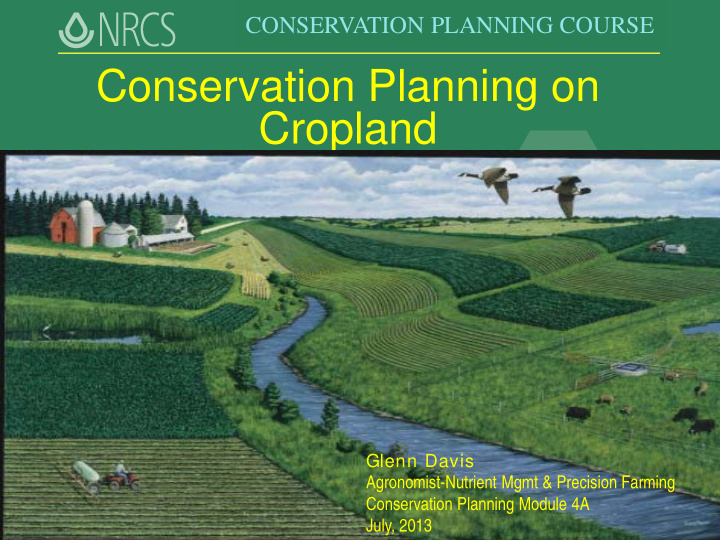



CONSERVATION PLANNING COURSE Conservation Planning on Cropland Glenn Davis Agronomist-Nutrient Mgmt & Precision Farming Conservation Planning Module 4A July, 2013
CONSERVATION PLANNING COURSE Overhead 3-22 Conservation Planning Steps 1. Identify Problems 2. Determine Objectives 2 1 3 3. Inventory Resources 4. Analyze Resource Data 5. Formulate alternatives 5 4 6 6. Evaluate Alternatives 7. Make Decisions 9 7 8 8. Implement the Plan 9. Evaluate the Plan
CONSERVATION PLANNING COURSE The conservation planning process on cropland is similar to conservation planning in other land uses. Cropland offers different options to address resource concerns.
CONSERVATION PLANNING COURSE Definition of Cropland (CRP) Land that is planted or considered planted to an agricultural commodity 4 of the previous 6 crop years
CONSERVATION PLANNING COURSE • Cropland - Altered from natural state • Productive! • More Vulnerable!
CONSERVATION PLANNING COURSE • Stewardship challenge • Keep the land productive • Protect resources
CONSERVATION PLANNING COURSE Identify Problems & Opportunities- Resource Concerns Physical Soil Water Air Plants Animals
CONSERVATION PLANNING COURSE Objective 1: Protect the Soil Resource • Erosion by Water
CONSERVATION PLANNING COURSE Objective 1: Protect the Soil Resource • Erosion by Wind
CONSERVATION PLANNING COURSE Objective 1: Protect the Soil Resource Degradation by excessive tillage, excessive salt buildup
CONSERVATION PLANNING COURSE Objective 2: Protect Water Resources
CONSERVATION PLANNING COURSE Objective 3: Meet Environmental Regulations
CONSERVATION PLANNING COURSE Soils • Reduce water and wind erosion • Increase fertility • Reduce salinity • Increase carbon deposition
CONSERVATION PLANNING COURSE Water • Increase irrigation efficiency • Minimize nutrient loading • Reduce runoff and leaching • Decrease pollutant loading
CONSERVATION PLANNING COURSE Air • Reduce atmospheric CO 2 flux, N 2 O flux • Reduce chemical drift • Reduce ammonia loss
CONSERVATION PLANNING COURSE Plants • Plant suitability • Crop yield • Minimize noxious and invasive species • Increase forage quality
CONSERVATION PLANNING COURSE Animals • Enhancing fish and wildlife habitat • Enhance domestic animal shelter, food and water quality • Reduce animal stress (grazing)
CONSERVATION PLANNING COURSE Human Factors • Consider the farmers facility, machinery, and economic situation • Consider the farm family and family farm dynamics • Willingness to change?
CONSERVATION PLANNING COURSE
CONSERVATION PLANNING COURSE Quality Criteria • What are the “Quality Criteria?” – Establish performance standards for sustainable resource use • Where do you find them? – FOTG Section III Resource Quality Criteria-RMS
CONSERVATION PLANNING COURSE Conservation Practice Effects • After Resource Concern(s) identified: – What Conservation Practice(s) are best? – Use the Conservation Practice Physical Effects (CPPE) matrix – Found in FOTG Section V
CONSERVATION PLANNING COURSE The Natural Resources Conservation Service provides leadership in a partnership effort to help people conserve, maintain, and improve our natural resources and environment.
Recommend
More recommend